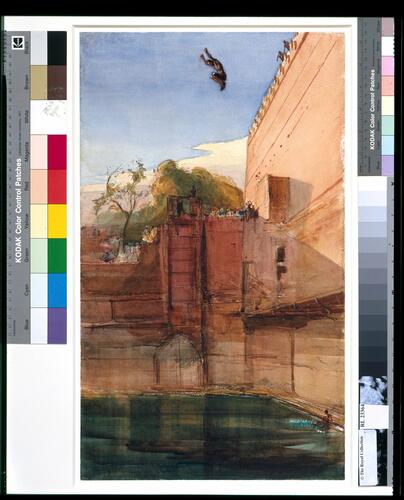Sydney Prior Hall (1842-1922)
Divers leaping at Fatehpur Sikri 29 Jan 1876
Watercolour over pencil with touches of gum arabic | 51.4 x 30.2 cm (sheet of paper) | RCIN 923364
-
The opening of the Suez Canal in 1869 allowed much easier travel between Britain and India, and Albert Edward, Prince of Wales, made the first royal tour of the country in 1875-6. He was accompanied by the artists Sydney Prior Hall and William Simpson (1818-72), who joined the Prince’s retinue on board HMS Serapis at Brindisi in Italy in October 1875. The royal party sailed via Athens, Cairo and Aden to reach Bombay on 8 November, then toured the Indian coast to Ceylon (Sri Lanka), Madras and Calcutta. The Prince travelled across the country to Delhi and Lahore, returning to Bombay on 10 March 1876 and sailing home via Malta, Spain and Portugal.
Simpson travelled as an artist for The Illustrated London News, which reproduced many of his drawings, and only a few were subsequently acquired by the Prince or Queen Victoria. Hall however was working for the Prince, and 270 of his drawings and watercolours from the tour are now in the Royal Library. A number of these were reproduced in The Prince of Wales’s Tour. A Diary in India, the collected dispatches of William Russell, who was both Special Correspondent to the Times and Honorary Private Secretary to the Prince for the tour; and an exhibition of the many gifts received by the Prince, including some of Hall’s watercolours, was held at the South Kensington Museum on the return of the party.
The Prince of Wales reached Fatehpur Sikri, 25 miles (40 km) to the west of Agra in Uttar Pradesh, on 29 January 1876. The huge palace complex in red sandstone was intended to be the capital of the Mughal Emperor Akbar; it was supposedly begun in thanks for the birth of Akbar’s heir Jahangir in 1569, but after fifteen years of construction the lack of an adequate water supply led to the abandonment of the site. By the time of the Prince’s visit, the palace was already an established tourist attraction:
’Close beside [the Great Gate] is a deep well, into which, for the amusement of visitors (and a consideration), children leap from an astonishing height. Mounting the lofty building till they seem babies in the distance, they stand between the parapets of the upper wall; and when they see that the visitors’ attention is attracted, they scream out a salutation to the sahibs, and leap feet foremost from the dizzy height. In the next instant they flash down through the air before you, and in the next, dexterously closing their feet at the very moment of contact, they pierce the weed-covered water far below you. It seems an awful way of making a livelihood; but they themselves declare that there is no tradition of a single accident.’
Text adapted from Holbein to Hockney: Drawings from the Royal CollectionProvenance
Painted for Albert Edward, Prince of Wales (later King Edward VII)
-
Medium and techniques
Watercolour over pencil with touches of gum arabic
Measurements
51.4 x 30.2 cm (sheet of paper)
Object type(s)
Other number(s)
RL 23364









